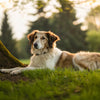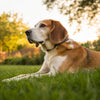Can Dogs Eat After Exercise? Understanding the Best Feeding Practices for Your Pup
- Houndsy
Table of Contents
- Introduction
- The Importance of Meal Timing
- Developing an Optimal Feeding Schedule
- Understanding Canine Nutrition After Exercise
- Signs of Digestive Distress
- Fostering a Positive Feeding Experience
- Conclusion
- FAQ
Introduction
As devoted dog owners, we all want what’s best for our furry companions, especially when it comes to their health and nutrition. Did you know that the timing of your dog's meals can significantly impact their digestive health and overall well-being? For instance, feeding your dog right after exercise can lead to serious digestive issues, such as bloating or gastric dilatation-volvulus (GDV). This blog post will explore the important question: can dogs eat after exercise?
We will delve into the science of canine digestion, the ideal timing for meals in relation to exercise, and how to structure your dog’s feeding schedule for optimal health. By the end of this article, we hope to empower you with the knowledge to make informed decisions about your dog's feeding routine, ensuring they stay healthy, happy, and energized.
The Importance of Meal Timing
Feeding your dog at the right times is essential for their digestive health and energy levels. When your dog exercises, their body prioritizes blood flow to the muscles, heart, and lungs, which can reduce blood flow to the digestive system. This means that if you feed your dog immediately after exercise, their body may not efficiently process the food, leading to discomfort and potential health issues.
How Exercise Affects Digestion
When dogs engage in physical activity, several physiological changes occur:
- Blood Flow Redistribution: During exercise, blood flow is diverted away from the digestive tract to support the muscles and heart. This can slow down the digestion process.
- Increased Risk of GDV: Feeding soon after exercise can increase the risk of bloat, particularly in large or deep-chested breeds. GDV is a serious condition that can be life-threatening and requires immediate veterinary attention.
- Energy Needs: After vigorous exercise, your dog’s body needs to recover, which includes replenishing energy stores. Proper nutrition plays a critical role in this recovery process.
Recommended Waiting Periods
To protect your dog’s digestive health, it is generally recommended to wait:
- At least 30 to 60 minutes after exercise before feeding your dog. This allows their body to cool down and their digestion to stabilize.
- A minimum of one hour before exercising post-meal to avoid discomfort and reduce the risk of GDV.
These time frames can vary based on your dog's age, breed, and activity level, so it's essential to adjust accordingly.
Developing an Optimal Feeding Schedule
Establishing a feeding schedule that takes exercise into account is crucial for your dog's well-being. Here are some tips to help you create a routine that works:
1. Feed Smaller, More Frequent Meals
Instead of one or two large meals, consider splitting your dog's daily food intake into smaller portions spread throughout the day. This can help with digestion and keep your dog’s energy levels stable.
2. Monitor Exercise Intensity
The type and intensity of exercise your dog engages in can dictate their nutritional needs. For example, a leisurely walk requires less recovery time than a rigorous run. Adjust your feeding schedule based on their activity level.
3. Hydration Matters
Always ensure your dog has access to fresh water before and after exercise. Hydration is vital for digestion and recovery.
4. Choose the Right Food
Selecting high-quality dog food is essential. Look for options with a good balance of protein, fats, and carbohydrates. Lean meats, whole grains, and vegetables can provide the necessary nutrients for recovery.
5. Consider Age and Breed
Puppies and senior dogs may have different dietary needs than adult dogs. Puppies may require more frequent feeding, while older dogs may need specific diets to support their health.
Understanding Canine Nutrition After Exercise
Feeding your dog the right foods after exercise is just as important as when you feed them. Here are some key points to consider:
Nutritional Needs Post-Exercise
- Protein: After exercise, your dog’s muscles require protein for repair and recovery. Look for dog food with high protein content (at least 26%) to support muscle health.
- Healthy Fats: Fats are an excellent source of energy and help sustain your dog during recovery. Ensure that the food you choose has a good fat content to promote energy levels.
- Carbohydrates: While dogs primarily burn fat for energy, carbohydrates can help replenish glycogen stores after strenuous exercise. Whole grains can be an excellent source of digestible carbohydrates.
Incorporating Fresh Foods
Incorporating fresh fruits and vegetables can enhance your dog's diet. Foods like carrots, apples, and green beans can provide vitamins and minerals essential for overall health.
Signs of Digestive Distress
As responsible pet owners, it’s essential to recognize the signs that your dog may be experiencing digestive distress. Common indications include:
- Vomiting: If your dog is frequently vomiting after meals or exercise, it may indicate a problem with their feeding schedule.
- Swollen Abdomen: A distended or hard belly could be a sign of bloat, requiring immediate veterinary attention.
- Excessive Drooling: This can be a sign of nausea or discomfort.
If you notice any of these signs, consult your veterinarian to address the issue promptly.
Fostering a Positive Feeding Experience
Feeding time should be a pleasant experience for your dog. Here are some tips to enhance their mealtime:
- Create a Calm Environment: Minimize distractions and ensure a quiet space for your dog to eat.
- Use Interactive Feeders: These can engage your dog mentally and slow down their eating pace, helping to prevent digestive issues.
- Develop a Routine: Dogs thrive on routine. Consistent feeding times will help establish good habits.
Conclusion
Understanding the relationship between exercise and feeding is crucial for promoting your dog's health and happiness. By adhering to recommended waiting periods and developing a structured feeding routine, we can ensure our furry friends receive the nutrition they need without risking their digestive health. Remember, the goal is to support their recovery and maintain their energy levels while enjoying their favorite activities.
If you’re looking to simplify your dog-feeding experience even further, consider exploring the Houndsy Kibble Dispenser. With its innovative design, you can provide your dog with perfectly portioned meals without the hassle. Check it out here.
FAQ
Q: Can I feed my dog immediately after a workout?
A: It is advised to wait at least 30 to 60 minutes after exercise before feeding your dog to avoid digestive issues.
Q: How long should I wait before exercising my dog after a meal?
A: You should wait at least one hour after feeding your dog before engaging in exercise to ensure their stomach is settled.
Q: What should I feed my dog after exercise?
A: A balanced diet high in protein and healthy fats is best for recovery. Consider incorporating lean meats, whole grains, and fresh fruits and vegetables.
Q: How can I tell if my dog is experiencing digestive distress?
A: Look for signs such as vomiting, a swollen abdomen, or excessive drooling. If you notice these symptoms, consult your veterinarian.
Q: Are there specific breeds that are more prone to bloat?
A: Yes, large or deep-chested breeds like Great Danes, Dobermans, and Boxers are at higher risk for bloat and should be monitored closely regarding feeding and exercise timing.












